
The geometer moths are moths belonging to the family Geometridae of the insect order Lepidoptera, the moths and butterflies. Their scientific name derives from the Ancient Greek geo γεω, and metron μέτρον "measure" in reference to the way their larvae, or inchworms, appear to measure the earth as they move along in a looping fashion. Geometridae is a very large family, containing around 23,000 described species; over 1400 species from six subfamilies are indigenous to North America alone. A well-known member is the peppered moth, Biston betularia, which has been the subject of numerous studies in population genetics. Several other geometer moths are notorious pests.
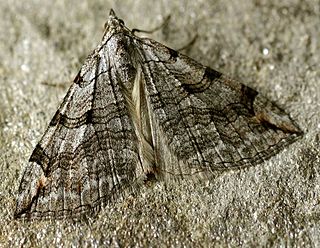
The treble-bar or St. John's wort inchworm is a moth of the family Geometridae. the species was first described by Carl Linnaeus in his 1758 10th edition of Systema Naturae. It is found throughout the Palearctic region and the Near East.

The mottled beauty is a moth of the family Geometridae. The species was first described by Carl Linnaeus in his 1758 10th edition of Systema Naturae.
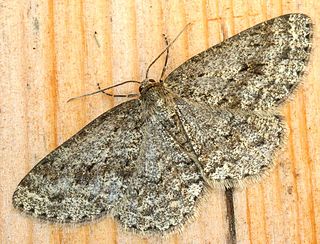
The engrailed and small engrailed are moths of the family Geometridae found from the British Isles through central and eastern Europe to the Russian Far East and Kazakhstan. The western Mediterranean and Asia Minor and the Caucasus represent the southern limit of the distribution. In the north, the distribution area ends at the Arctic Circle. It also occurs in North America. Debate exists as to whether they make up one species, or whether E. crepuscularia actually refers only to the small engrailed, with the engrailed proper being separable as E. bistortata.
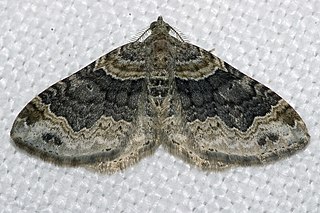
Xanthorhoe ferrugata, the dark-barred twin-spot carpet, is a moth of the genus Xanthorhoe in the family Geometridae. It was first described by Carl Alexander Clerck in 1759 and has a Holarctic distribution.

Cyclophora punctaria, the maiden's blush, is a moth of the family Geometridae. The species was first described by Carl Linnaeus in his 1758 10th edition of Systema Naturae. The species is mainly prevalent in Central and Eastern Europe. In the north, its distribution extends to southern Fennoscandia and the British Isles, in the west via France to parts of northern Spain, in the south via Italy, the Balkan Peninsula to Asia Minor. The eastern border of the distribution is roughly the Ural. In the Caucasus area, the nominate subspecies is replaced by the subspecies C. punctaria fritzae. The range of this subspecies extends as far as Iran.Cyclophora punctaria is found mainly in wooded areas with oak scrub and oak forests. In Central Europe it rises up to 700 metres in the hills, rarely up to 1,200 metres in the Alps, and regularly rises to 1,300 metres in southern Europe.

Thera obeliscata, the grey pine carpet, is a moth of the family Geometridae. It is found throughout north and central Europe and east across the Palearctic to Siberia, and south to the Caucasus and Transcaucasia. In the Alps it can be found at an altitude of over 1500 metres.
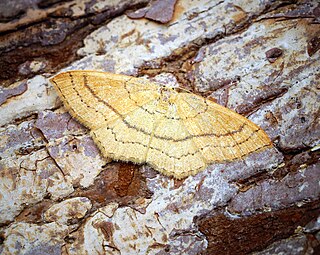
Cyclophora linearia, the clay triple-lines, is a moth of the family Geometridae. The species was first described by Jacob Hübner in 1799 and it can be found in Europe and Britain.

Notoreas is a genus of geometer moths endemic to New Zealand. The genus was described by Edward Meyrick in 1885.
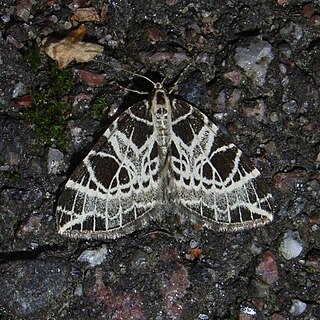
Eustroma reticulatum, the netted carpet, is a moth of the family Geometridae. The species was first described in 1775, by the Austrian lepidopterists Michael Denis and Ignaz Schiffermüller.
Louis Beethoven Prout (1864–1943) was an English entomologist and musicologist.
William Warren was an English entomologist who specialised in Lepidoptera.
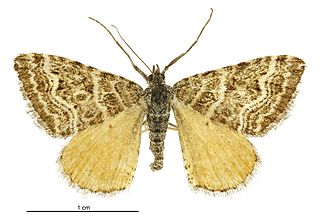
Xanthorhoe bulbulata is a species of moth in the family Geometridae. It is endemic to New Zealand. It is classified as critically endangered by the Department of Conservation.

Notoreas blax is a species of moth in the family Geometridae. This species is endemic to New Zealand. This moth frequents alpine habitat and can be found in the Canterbury and Otago regions.

Notoreas chioneres is a species of moth in the family Geometridae. This species is endemic to New Zealand.













